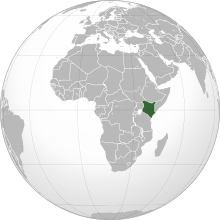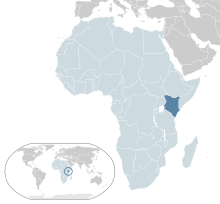ڪينيا
ڪينيا ((انگريزي: Kenya )) سرکاری طور تی، ڪينيا جی جمہوریہ (Republic of Kenya)، آفريڪا جي ڏکڻ اوڀر ۾ واقع، آفريڪن یونین جو میمبر ھڪ ملڪ جنھن جي گادي جو هنڌ نيروبي آھي.[12] سال 2019ع جي مردم شماري ۾ 47.6 ملين کان وڌيڪ جي آبادي سان، ڪينيا دنيا ۾ 28 هين سڀ کان وڌيڪ آبادي وارو ملڪ آهي ۽ آفريڪا ۾ ستین سڀ کان وڌيڪ آبادي وارو ملڪ آهي. ڪينيا جي گاديءَ جو هنڌ ۽ سڀ کان وڏو شهر نيروبي آهي، جڏهن ته ان جو سڀ کان پراڻو ۽ ٻيو وڏو شهر، ممباسا جو وڏو بندرگاهه شهر آهي، جيڪو هندي سمنڊ ۾ ممباسا ٻيٽ ۽ ان جي آس پاس جي مکيه زمين تي واقع آهي. ممباسا سال 1889ع کان 1907ع تائين برٽش ايسٽ آفريڪا پروٽيڪٽوريٽ جي گاديءَ جو هنڌ هو، جنهن ۾ هاڻ ڪينيا ۽ ڏکڻ اولهه صوماليا جو گهڻو حصو شامل هو. ٻين اهم شهرن ۾ ڪيسمو ۽ نڪورو شامل آهن. ڪينيا جون سرحدون اتر اولهه ۾ ڏکڻ سوڊان، اتر ۾ ايٿوپيا، اوڀر ۾ صوماليا، اولهه ۾ يوگینڊا، ڏکڻ ۾ تنزانيا ۽ ڏکڻ اوڀر ۾ هندي سمنڊ سان لڳل آهن. ڪينيا جي جاگرافي، آبهوا ۽ آبادي وڏي پئماني تي مختلف آهي، سرد برف سان ڍڪيل جبلن جي چوٽي (بيٽيان، نيليون ۽ پوائنٽ لينانا آن مائونٽ ڪينيا) کان وٺي وسيع ڀرپاسي وارا ٻيلا، جهنگلي جيوت ۽ زرخيز زرعي علائقا، اولهه ۾ معتدل آبهوا ۽ ڳڻپ ۽ واديءَ کان اڳتي ڳڻپ تائين، خشڪ گهٽ زرخيز خشڪ ۽ نيم خشڪ علائقا ۽ مطلق ريگستان (چلبي ريگستان ۽ نيري ريگستان) تائین مختلف آهي.
ڪينيا جي جمهوريه جمھوريا ڪينيا (سواحلي) | |||||
|---|---|---|---|---|---|
| |||||
| گادي جو هنڌ | نیروبي 1°16′S 36°48′E / 1.267°S 36.800°E | ||||
| سڀ کان وڏو شهر | نیروبي | ||||
| دفتري ٻوليون | |||||
| قومی بولی | Swahili[1] | ||||
| نسلي گروھ (2019 census) |
| ||||
| مذهب (2019 census) |
| ||||
| مقامي آبادي | Kenyan | ||||
| حڪومت | Unitary presidential republic | ||||
• President | William Ruto | ||||
• Deputy President | ریگاتی گاچاگوا | ||||
• Senate Speaker | اماسون ڪنگي | ||||
• Assembly Speaker | موسی ویتنگولا | ||||
• Chief Justice | مارتھا ڪومي | ||||
| مقننه | Parliament | ||||
| Senate | |||||
| National Assembly | |||||
| Independence from the United Kingdom | |||||
• Dominion | 12 December 1963 | ||||
• Republic | 12 December 1964 | ||||
• Current Constitution | 27 August 2010 | ||||
| پکيڙ | |||||
• جملي | 580٬367 km2 (224٬081 sq mi)[2][3] (48th) | ||||
• پاڻي (%) | 2.3 | ||||
| آبادي | |||||
• 2024 اندازو | 52,428,000[4] (28th) | ||||
• 2019 مردم شماري | 47,564,296[5] | ||||
• گھاٽائي | 82 /km2 (212.4 /sq mi) (124th) | ||||
| جِي ڊي پي (مساوي قوت خريد ) | 2023 لڳ ڀڳ | ||||
• ڪل | |||||
• في سيڪڙو | |||||
| جِي. ڊي. پي (رڳو نالي ۾ ) | 2023 لڳ ڀڳ | ||||
• ڪل | |||||
ڪينيا جا ابتدائي رهواسي شڪار گڏ ڪندڙ (Hunter-Gatherers) هئا. آرڪيالاجيڪل تاريخن سان لاڳاپيل آثارن ۽ کنڊ جي مواد جي مطابق، ڪشيٽڪ ڳالهائيندڙ پهريون ڀيرو ڪينيا جي هيٺاهين علائقن ۾ 3,200 ق.م ۽ 1,300 ق.م نيلوٽڪ ڳالهائيندڙ چرواھا (ڪينيا جي نيلوٽڪ ڳالهائيندڙن جا ابا ڏاڏا) اڄوڪي ڏکڻ سوڊان مان ڪينيا ۾ 500 ق.م ء بنتو قوم 250 ق.م م آیا.
يورپين جو رابطو 1500ع ۾ پورچوگالي سلطنت سان شروع ٿيو، ۽ ڪينيا جي اثرائتي نوآبادي جي شروعات 19 صدي عيسويءَ ۾ يورپ جي گهرن جي ڳولا دوران ٿي. جديد ڪينيا 1895ع ۾ برٽش ايمپائر پاران قائم ڪيل حفاظتي رياست مان اڀري آيو ۽ ان کان پوءِ ڪينيا ڪالوني، جيڪا 1920ع ۾ شروع ٿي. برطانيه ۽ ڪالوني جي وچ ۾ ڪيترائي تڪرار ماو مائو انقلاب جو سبب بڻيو، جيڪو 1952ع ۾ شروع ٿيو، ۽ ان جي آزادي جو اعلان 1963ع ۾ ٿيو. آزاديءَ کان پوءِ ڪينيا دولت مشترڪه جو ميمبر رهيو.
موجوده آئين 2010 ۾ منظور ڪيو ويو ۽ 1963 جي آزاديء واري آئين کي تبديل ڪيو ويو. ڪينيا هڪ صدارتي نمائندو جمهوري جمهوريه آهي، جنهن ۾ چونڊيل عملدار عوام جي نمائندگي ڪن ٿا ۽ صدر رياست ۽ حڪومت جو سربراهه آهي. ڪينيا گڏيل قومن، دولت مشترڪه، ورلڊ بئنڪ، بين الاقوامي مالیاتی فنڊ، ڪوميسا COMESA، بين الاقوامي فوجداري عدالت، گڏوگڏ ٻين بين الاقوامي تنظيمن جو ميمبر آهي. سالانی 1,840 جي GNI سان، ڪينيا هڪ هيٺين وچولي آمدني معيشت آهي. ڪينيا جي معيشت اڀرندي ۽ وچ آفريڪا ۾ ايٿوپيا کان پوءِ ٻئي نمبر تي وڏي آهي. نيروبي سان گڏ هڪ اهم علائقائي تجارتي مرڪز طور ڪم ڪري رهيو آهي. زراعت سڀ کان وڏو شعبو آهي؛ چانهه ۽ ڪافي روايتي نقد فصل آهن، جڏهن ته تازو گلن تيزي سان وڌندڙ برآمد آهن. سروس انڊسٽري، خاص طور تي سياحت، پڻ هڪ اهم معاشي ڊرائيور آهي. ڪينيا ايسٽ آفريڪن ڪميونٽي ٽريڊ بلاڪ جو ميمبر آهي، جيتوڻيڪ ڪي بين الاقوامي واپاري تنظيمون ان کي گريٽر هارن آف آفريڪا جي حصي طور درجه بندي ڪن ٿيون. آفريڪا ڪينيا جي سڀ کان وڏي ايڪسپورٽ مارڪيٽ آهي.
a population of more than 47.6 million in the 2019 census,[13] Kenya is the 28th most populous country in the world[5] and 7th most populous in Africa. Kenya's capital and largest city is Nairobi, while its oldest and second largest city, is the major port city of Mombasa, situated on Mombasa Island in the Indian Ocean and the surrounding mainland. Mombasa was the capital of the British East Africa Protectorate, which included most of what is now Kenya and southwestern Somalia, from 1889 to 1907. Other important cities include Kisumu and Nakuru. Kenya is bordered by South Sudan to the northwest, Ethiopia to the north, Somalia to the east, Uganda to the west, Tanzania to the south, and the Indian Ocean to the southeast. Kenya's geography, climate and population vary widely, ranging from cold snow-capped mountaintops (Batian, Nelion and Point Lenana on Mount Kenya) with vast surrounding forests, wildlife and fertile agricultural regions to temperate climates in western and rift valley counties and further on to dry less fertile arid and semi-arid areas and absolute deserts (Chalbi Desert and Nyiri Desert).
Kenya's earliest inhabitants were hunter-gatherers, like the present-day Hadza people.[14][15] According to archaeological dating of associated artifacts and skeletal material, Cushitic speakers first settled in Kenya's lowlands between 3,200 and 1,300 BC, a phase known as the Lowland Savanna Pastoral Neolithic. Nilotic-speaking pastoralists (ancestral to Kenya's Nilotic speakers) began migrating from present-day South Sudan into Kenya around 500 BC.[16] Bantu people settled at the coast and the interior between 250 BC and 500 AD.[17]
European contact began in 1500 AD with the Portuguese Empire, and effective colonisation of Kenya began in the 19th century during the European exploration of the interior. Modern-day Kenya emerged from a protectorate established by the British Empire in 1895 and the subsequent Kenya Colony, which began in 1920. Numerous disputes between the UK and the colony led to the Mau Mau revolution, which began in 1952, and the declaration of independence in 1963. After independence, Kenya remained a member of the Commonwealth of Nations. The current constitution was adopted in 2010 and replaced the 1963 independence constitution.
Kenya is a presidential representative democratic republic, in which elected officials represent the people and the president is the head of state and government.[18] Kenya is a member of the United Nations, the Commonwealth, World Bank, International Monetary Fund, COMESA, International Criminal Court, as well as other international organisations. With a GNI of 1,840,[19] Kenya is a lower-middle-income economy. Kenya's economy is the second largest in eastern and central Africa, after Ethiopia, with Nairobi serving as a major regional commercial hub.[20] Agriculture is the largest sector; tea and coffee are traditional cash crops, while fresh flowers are a fast-growing export. The service industry is also a major economic driver, particularly tourism. Kenya is a member of the East African Community trade bloc,[21][22] though some international trade organisations categorise it as part of the Greater Horn of Africa.[23] Africa is Kenya's largest export market, followed by the European Union.[24]




